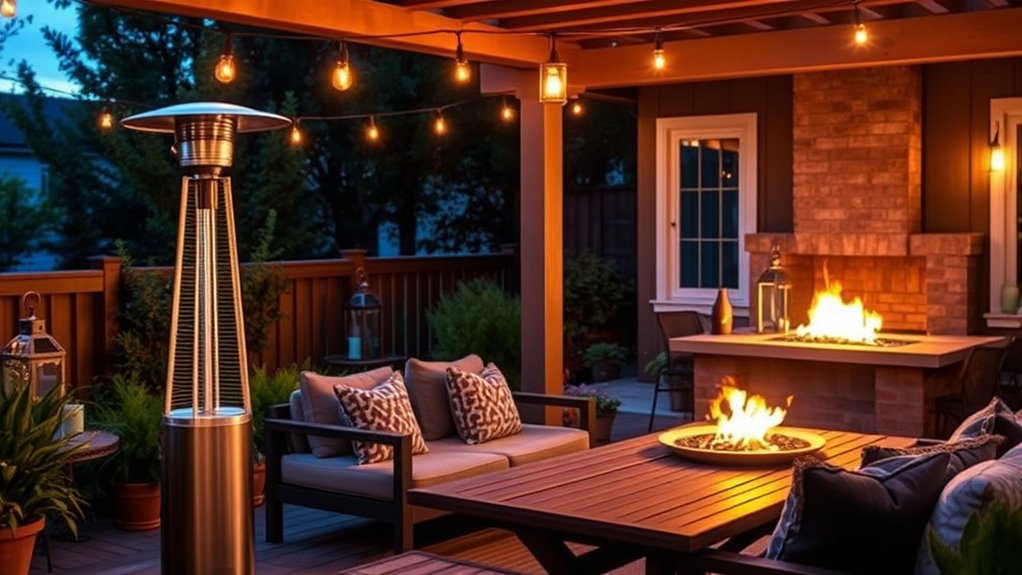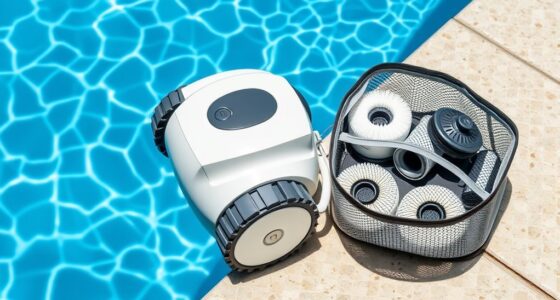To extend your outdoor living season, you can choose between patio heaters and fire pits based on your needs. Patio heaters offer even warmth with adjustable settings, while fire pits provide cozy, radiant heat ideal for social gatherings. Consider fuel options like propane, natural gas, or wood, and weigh initial costs against ongoing expenses. Proper safety and maintenance guarantee lasting enjoyment. Keep exploring for tips on selecting the perfect addition to warm up your outdoor space.
Key Takeaways
- Fire pits provide intense, localized heat ideal for cozy gatherings, extending outdoor use into cooler evenings.
- Patio heaters offer even heating and adjustable controls, ensuring consistent comfort across larger outdoor spaces.
- Both options increase outdoor usability, allowing you to enjoy your patio or yard for longer seasons.
- Consider fuel types and installation costs to choose the most efficient and cost-effective heating solution.
- Complement with ambient lighting and durable materials to enhance ambiance and weather resistance for year-round enjoyment.
Comparing Heat Output and Coverage Capabilities
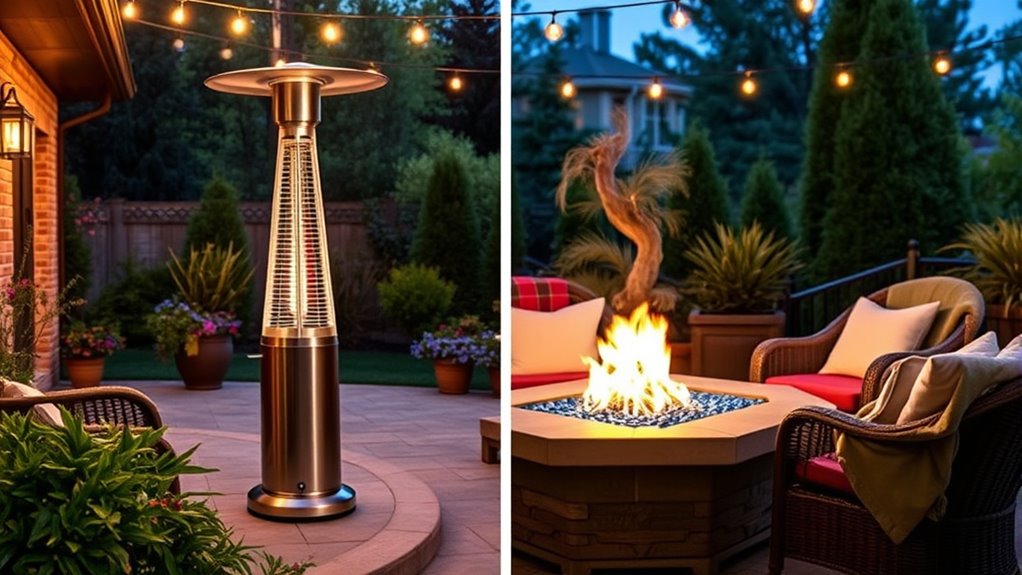
When comparing heat output and coverage capabilities, fire pits generally produce higher maximum BTUs than patio heaters, making them suitable for larger or more intense heating needs. Fire pits have a broader BTU range—from 30,000 to 150,000 BTUs—allowing for customizable warmth depending on fuel type and size. They focus heat around a central flame, providing intense, radiant warmth for a localized area. Temperature control in fire pits depends on adjusting fuel, like adding more wood or increasing gas flow, but it’s less precise than patio heaters. Fuel efficiency varies, with wood burning offering more heat but requiring more effort. Patio heaters, with BTUs from 5,000 to 50,000, distribute heat more evenly and provide consistent coverage, though their maximum output is limited by design. Additionally, heat distribution methods differ between the two, affecting how effectively they warm outdoor spaces.
Exploring Fuel Options and Energy Efficiency
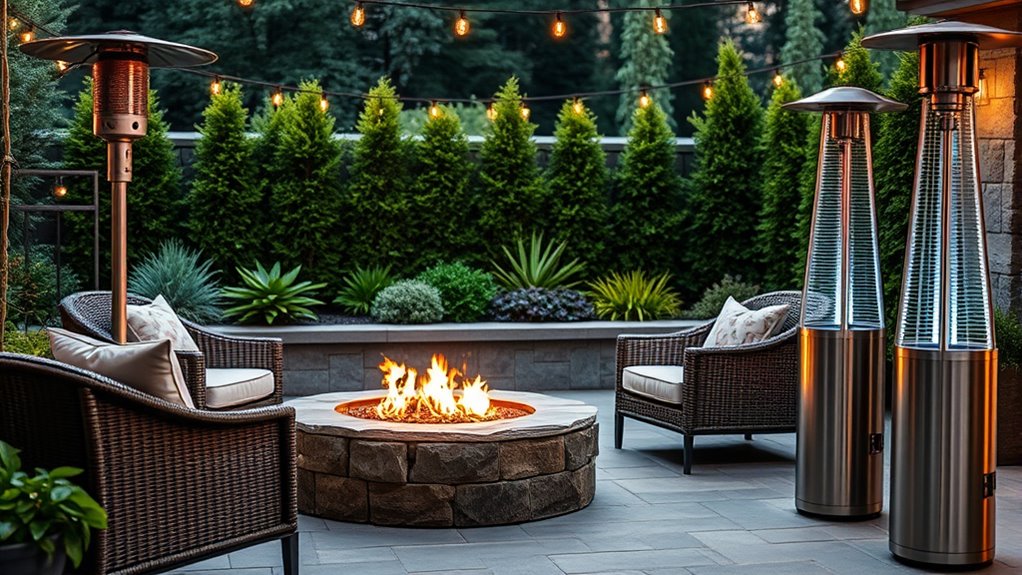
Choosing the right fuel option for your patio heater or fire pit can substantially impact both energy efficiency and environmental footprint. Fuel storage plays a key role; propane tanks are portable but require regular refills, while natural gas connects directly to your home’s lines, providing continuous supply and lower emission levels. Bioethanol burns cleanly with minimal smoke, making it eco-friendly, but it often has shorter burn times and higher fuel costs. Wood offers high heat but produces smoke and ash, affecting air quality and requiring ventilation. Gel fuels are portable and smokeless but burn for shorter periods. Overall, natural gas tends to be the most energy-efficient with lower emissions, while propane offers flexibility but at a higher operational cost. Natural gas units generally have higher upfront installation costs but lower ongoing fuel expenses, making them cost-effective in the long run. Additionally, considering the fuel efficiency of your chosen heating option can lead to significant savings over time, especially when paired with proper insulation and coverage. Your choice depends on balancing fuel storage convenience, energy efficiency, and environmental impact.
Cost Considerations: Investment and Ongoing Expenses
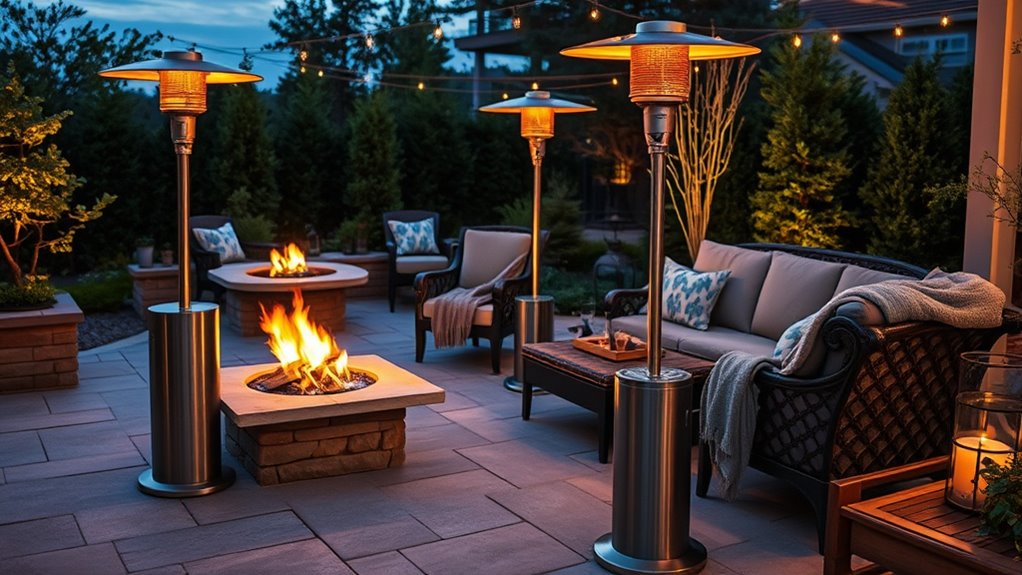
Initial costs for patio heaters and fire pits vary widely, impacting your overall budget from the start. Fire pits often have lower material costs—basic wood-burning models start around $129, while high-end gas or masonry units can reach $1,000. Patio heaters tend to be pricier upfront, especially commercial-grade models exceeding $150. Material choices considerably influence initial costs, as shown below:
| Feature | Material Costs | Warranty Coverage |
|---|---|---|
| Fire pits | Steel, stone, aluminum: $129–$1000 | Usually 1–3 years, varies by brand |
| Patio heaters | Stainless steel, durable plastics | Often 1–2 years, some offer extended |
| Installation | Gas line setup, labor costs | Varies based on complexity |
Long-term expenses include fuel, maintenance, and potential replacements, which should factor into your investment plan. Additionally, considering proper maintenance can help extend the lifespan of your outdoor heating equipment.
Safety, Environmental Impact, and Maintenance Needs
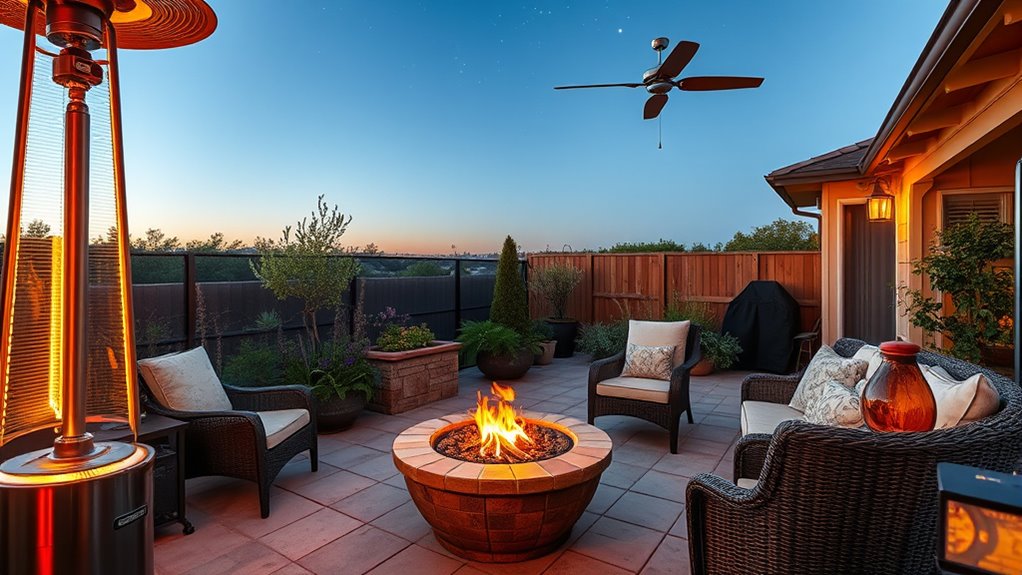
Ensuring safety, minimizing environmental impact, and maintaining your patio heaters and fire pits are essential for enjoyable and responsible use. Fire safety is paramount—place heaters on stable, flat surfaces, keep fire pits supervised, and maintain safe distances from flammable objects and walls. Regular cleaning and proper storage help prevent malfunctions and extend lifespan. For environmental impact, choose electric heaters or sustainable fuel options, and avoid indoor use to prevent carbon monoxide risks. Fire pits emit particulate matter, affecting air quality, so use responsibly. Routine maintenance checks for leaks and damage are crucial for safe operation. Remember, safety measures like spark screens and proper extinguishing of fires protect your property and loved ones, ensuring your outdoor decor remains both beautiful and safe. Additionally, using protective covers during the off-season can help prevent weather-related damage and prolong the life of your equipment. Incorporating environmentally friendly fuels can further reduce the ecological footprint of your outdoor heating options.
Enhancing Ambiance and Selecting the Right Style

Enhancing the ambiance of your outdoor space with fire pits and patio heaters can transform ordinary evenings into memorable gatherings. Decorative accessories, like string lights or ornaments, add charm and elevate the setting. Choosing styles that match your space’s aesthetic—whether sleek, modern patio heaters or rustic fire pits—creates visual appeal. Material durability is vital; stainless steel, brick, or stone ensure your fixtures withstand weather and time, maintaining their look. Fire pits with dancing flames generate an elegant atmosphere, perfect for special occasions, while fire pits and heaters can extend outdoor living into cooler seasons. Fire pits can increase property value, especially with built-in styles, making them a worthwhile investment. By selecting the right style and accessories, you create a cozy, inviting environment that reflects your personal taste and enhances your outdoor experience. Additionally, selecting weather-resistant materials ensures your investment remains attractive and functional for years to come, emphasizing the importance of Material durability in outdoor fixtures.
Frequently Asked Questions
Which Outdoor Heating Option Is Better for Small Spaces?
When choosing an outdoor heating option for small spaces, you want a compact design that offers space-saving solutions. You should consider something portable, easy to move, and unobtrusive, so it doesn’t crowd your area. Look for a sleek, efficient heater that provides ample warmth without taking up too much room. This way, you maintain an inviting atmosphere while maximizing your limited outdoor space, making your outdoor experience comfortable and functional.
Can Patio Heaters Be Used Indoors Safely?
You shouldn’t use patio heaters indoors because of indoor safety and ventilation considerations. Gas patio heaters, like propane and natural gas types, produce carbon monoxide and pose fire risks in enclosed spaces. Poor ventilation can cause dangerous gas buildup. Instead, opt for electric or infrared heaters designed for indoor use—they’re safer, eliminate combustion risks, and don’t require special ventilation, ensuring your indoor environment stays safe and comfortable.
How Long Do Fire Pits Typically Last?
Oh, so you’re wondering how long your beloved fire pit will last? Well, brace yourself—most fire pits have a lifespan of 10 to 15 years with proper care. The durability of fire pits depends on materials like stainless steel and maintenance routines. Keep it clean and well-maintained, and you’ll enjoy those smoky nights for years. Neglect it, and it might just become a pile of rust and memories.
Are Electric Patio Heaters Effective in Cold Climates?
You might wonder if electric patio heaters work well in cold climates. They do, especially with infrared technology that heats objects and people directly, even below freezing. Compared to gas, electric models are safer—no fuel or fumes—and easier to use. However, their effectiveness drops in very windy or extremely cold conditions, so guarantee proper placement and weather-resistant features for safety and maximum performance in harsh weather.
What Are the Best Practices for Storing Fuel Safely?
When it comes to fuel storage, you need to prioritize safety precautions to prevent accidents. Always store fuels like propane outdoors in approved, ventilated racks, keeping cylinders upright and away from ignition sources. Follow proper distance guidelines from doors and traffic areas, and never store fuels inside your home. Regularly inspect containers for leaks or damage, and ensure they’re secured from tampering. These steps help keep your environment safe and compliant.
Conclusion
By choosing the right patio heater or fire pit, you extend your outdoor living season, enhance your space, and enjoy cozy gatherings. You compare heat output and coverage, explore fuel options and efficiency, consider costs and safety, and focus on ambiance and style. Ultimately, you create a warm, inviting environment that suits your needs, your style, and your lifestyle. Embrace the options, make informed choices, and transform your outdoor space into a year-round retreat.
